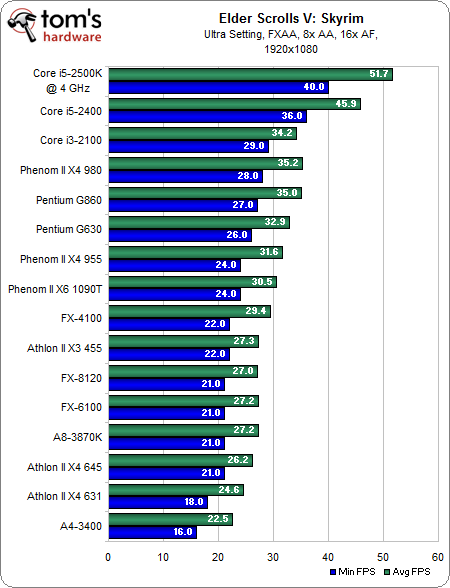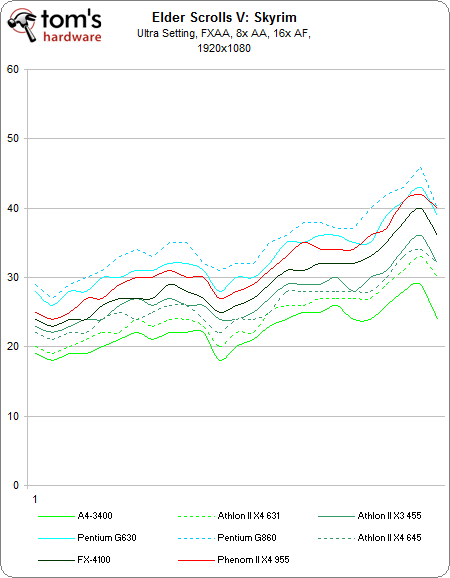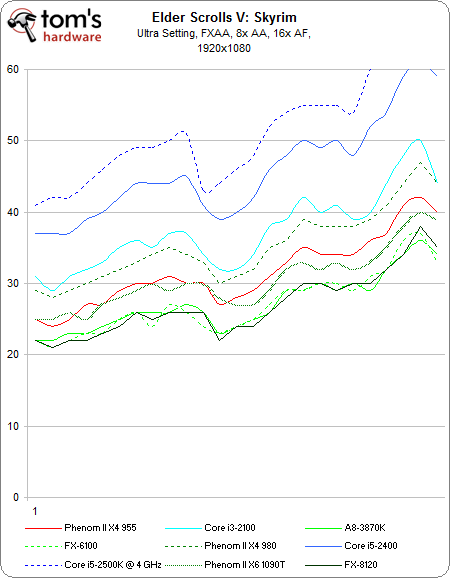Picking A Sub-$200 Gaming CPU: FX, An APU, Or A Pentium?
We really like to hunt down great values in the processor space. Since our last round-up of affordable CPUs, AMD released its Llano-based APUs and Bulldozer-based FX family. Also, Intel introduced a handful of Sandy Bridge-based Pentium chips.
Benchmark Results: Elder Scrolls V: Skyrim
Let’s start with Elder Scrolls V: Skyrim, a popular game that we know to be a relatively processor-bound.
We sorted this chart based on minimum frame rates, determining the slowest attainable delivered by each processor to be most important.
Immediately, we're impressed by how well the Sandy Bridge-based Pentium G630 and G860 perform, outscoring all of AMD's processors except for the Phenom II X4 980, which tenuously holds onto a 2 FPS lead over Intel's $80 budget processor. It's interesting that an IPC advantage is enough for a dual-core chip with 3 MB of shared L3 to outpace two times the cores and cache in the Phenom II X4 955.
The Core i5s stand out as the performance leaders, but the Core i3-2100 delivers an impressive result as well, especially considering its relatively low price. AMD’s FX CPUs don't do well at all here. Neither do the Athlon II X4 and Llano-based A4 and A8 APUs.
Let’s dig deeper, though, and consider frame rates over time. Because there's so much data to cover, we'll split these charts up based on cost, with AMD's $125 Phenom II X4 955 serving as the middle-point.
First, we see the Pentiums dominate this segment with performance that rarely dips below 30 FPS. The Phenom II X4 955 manages to place just slightly below the Pentium G630, and AMD's FX-4100 achieves a notably lower result, with only about half the benchmark above the 30 FPS mark. AMD’s Llano-based A4-3400 and Athlon II X4 631 do very poorly, unfortunately.
Now let’s look at more expensive models:
Get Tom's Hardware's best news and in-depth reviews, straight to your inbox.
You can still see the Phenom II X4 955 in red, with the Phenom II X6 1090T, FX-6100, FX-8120, and A8-3870K falling below it.
AMD’s best result comes from the Phenom II X4 980, which appears only slightly slower than Intel's Core i3-2100. The Core i5-2400 and overclocked Core i5-2500K never drop below 37 FPS, and usually stay above 40 FPS in this test.
Current page: Benchmark Results: Elder Scrolls V: Skyrim
Prev Page Test System And Benchmarks Next Page Benchmark Results: Battlefield 3Don Woligroski was a former senior hardware editor for Tom's Hardware. He has covered a wide range of PC hardware topics, including CPUs, GPUs, system building, and emerging technologies.
-
rambostyrer Another showcase of how disappointing the FX processor is in gaming terms.Reply
the fx-8120 outperformed by the i3-2100 -
compton Given how well my 2500K (and every other 2500K) overclocks, 4.3 is a good every day top turbo bin for 4 cores, and the performance increase vs. power consumption is fantastic. I don't want to add to the chorus of negativity to Bulldozer, but the Phenom II x6 should be kicked down to 32nm soon -- I just can't really think of any reason that someone should by Bulldozer over Intel or an X6. For those that can make use of it's particular strengths, it's price is certainly reasonable. And there is a lot to like about AMD motherboards too. The Phenom might be venerable, but it's not terrible and it's a lot more honest than Bulldozer.Reply
-
Youngmind Does anybody else still think of Pentium 4s and the other flops that Intel created when they see "Pentium?"Reply -
acerace So, is Pentium processors any good? Cause I think I want to upgrade my aging PC to that.Reply -
alidan YoungmindDoes anybody else still think of Pentium 4s and the other flops that Intel created when they see "Pentium?" yea... personally i like numbers, like (name) (number) and that tells me all i need to know about the chip, i dont like (name) (letter-number) and than i have to look crap to figure out what it is, though the whole i series bugs me because of that.Reply
comptonGiven how well my 2500K (and every other 2500K) overclocks, 4.3 is a good every day top turbo bin for 4 cores, and the performance increase vs. power consumption is fantastic. I don't want to add to the chorus of negativity to Bulldozer, but the Phenom II x6 should be kicked down to 32nm soon -- I just can't really think of any reason that someone should by Bulldozer over Intel or an X6. For those that can make use of it's particular strengths, it's price is certainly reasonable. And there is a lot to like about AMD motherboards too. The Phenom might be venerable, but it's not terrible and it's a lot more honest than Bulldozer.
if i had the money, id go i7, i woundt consider anything lower than that.
if i dont have the money, i would only consider the phenom II x4 or x6 line, as i prefer real cores, and the lowest real 4 core intel is over 200$ and the phenoms are 100-150ish.
granted i would wait for pilerdriver. -
Yargnit this really confirms what I've been thinking about the Intel "Pentium" models flying under the radar in the budget market.Reply
The i3-2100 is actually down to $110 on Newegg right now, but at $125 it made the Pentium models an absolute steal. You were paying nearly $40 more for .2 Ghz faster and hyper-threading compared to the G850 between $85-90. A $110 i3-2100 not only addresses this difference much better, but basically kills almost every AMD CPU above that price point, while the Pentium's kill the AMD CPU's below it.
The Phenom 2 x6's (which now appear to be all out of stock) for selective use, and maybe the FX4100 is really all AMD has left that's semi-viable anymore. IT's not looking good for AMD that's for sure. :\ -
de5_Roy thanks a lot for this article. cleared up a lot of things for me.Reply
it was great to see ph ii x4 955 outperform fx in gaming. imo it's the best gaming cpu from amd. fx4100's (and the rest of fx) overclocked (under)performance was sad.
but core i3 2100 and sandy bridge pentiums...damn...
i think intel sorta turned around the old 'pentium vs fx' (for gaming) with sandy bridge pentium vs bulldozer fx.
amd must do better with piledriver and trinity. :sweat: need more competition in cpu arena...
-
LuckyDucky7 @comptonReply
There isn't, and won't ever be, a 32nm die shrink to the Phenom IIs.
Bulldozer is IT, and that's all there is to it.
Maybe Piledriver will have some improvements, but they just won't be enough. Even if they could get IPC parity with the old Phenom IIs they still get run over by Pentiums and the i3-2100.
It will be interesting to see how Trinity performs but I'd be surprised if it wasn't just Bulldozer bolted on to a better GPU; IPC improvements might be there but I doubt they'll be as good as the Phenom IIs. The fall FX releases might get them to parity.
I'd like to see what performance the Ivy Bridge i3 will have; or if Intel will (unlikely) release a K-series for it- thus ensuring that sub-200-dollar overclocking is shelved for at least another 2 years if not indefinitely.


